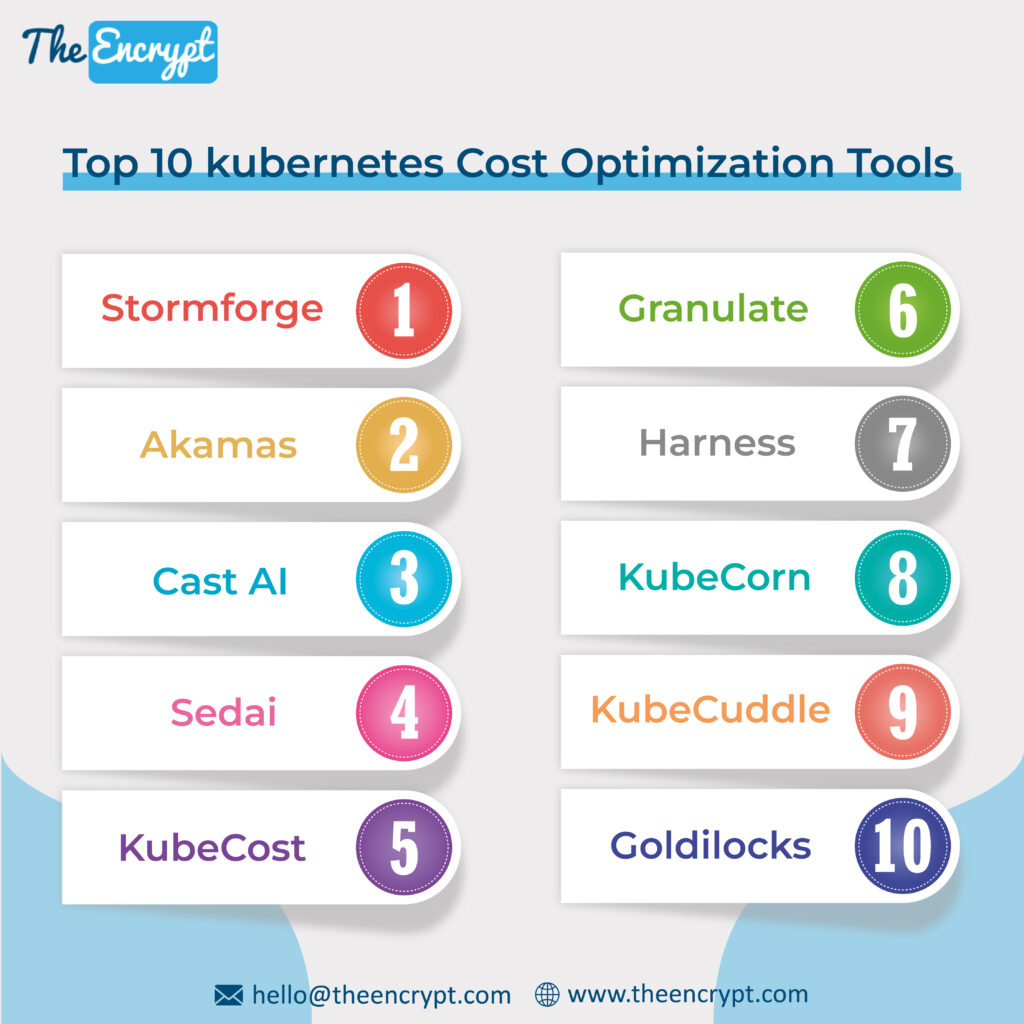
Kubernetes is a revolution in the world of cloud computing. Over virtualization, its mindful approach towards containerized deployment of applications on the cloud ensures proper resource utilization. However, just as everything comes at a cost, implementing Kubernetes can add to your cloud provider bills. But what if you can cut down the Kubernetes expenses? Yes, you can do it with the help of Kubernetes cost-optimization tools.
What are Kubernetes cost-optimization tools?
As the name suggests, Kubernetes cost-optimizations tools are third-party offerings that help you optimize your expenses due to containerized orchestration of applications. It overcomes the challenge of the invisibility of Kubernetes costs in the total cloud provider bills.
With such valuable insights, you can decide the workload and nodes to eliminate from Kubernetes according to their costs. Moreover, it also allows you to determine the appropriate scaling and resource requests for the proper utilization of Kubernetes. Hence, you can reduce Kubernetes costs, adding to your cloud expenses.
What are the top 10 Kubernetes cost-optimization tools?
There are numerous third-party vendors offering solutions for the cost-optimization of Kubernetes. However, only some are reliable and worth your investment. Hence, let us go through the top 10 Kubernetes cost-optimization tools.

1. Stormforge
Stormforge is one of the most versatile cost-optimization tools for Kubernetes. It focuses on improving cost-efficiency and enhancing the performance of containerized orchestrated applications.
But how does Stormforge achieve it? Well, it leverages the advantages of machine learning to analyse CPU and memory utilization by applications. This approach helps it to adjust the size of applications according to the changes in workload and allocate appropriate amounts of resources.
Hence, you can ensure the high performance and reliability of your applications deployed using Kubernetes besides maintaining cost-efficiency using Stormforge.
2. Akamas
Akamas is another ML-based Kubernetes cost optimization tool. It makes the most virtuous use of AI to recommend the optimal Kubernetes configuration. Thus, it enhances the performance, reliability, and cost-efficiency of live applications running on Kubernetes.
To undergo the complex task of exploring possible configurations, Akamas leverages Reinforcement learning, one of the best ML-based optimization techniques. This makes the process fully automated.
The optimal configuration is based on the custom goals and constraints you define. Hence, this Kubernetes cost-optimization tool considers your business objectives and real-time workloads for the most-efficient resource allocation and reduced costs.
3. Cast AI
Cast AI, an AI-driven tool, is a versatile platform for Kubernetes operations. It is a one-stop solution for automation, optimization, security, and cost management associated with Kubernetes.
Unlike many other Kubernetes cost-optimization tools, cast.ai works on the cluster level. The innovative blend of optimization and AI automation helps monitor the Kubernetes clusters for real-time traffic patterns and application requirements.
Hence, the thorough analysis helps the tool optimise the compute resource allocation and recommend the most appropriate configuration. In this way, you can reduce costs using Kubernetes clusters.
4. Sedai
Sedai is an AI-powered cloud platform associated with optimizing Kubernetes applications. It uses Machine Learning algorithms to scale resources up and down automatically. This helps organizations achieve a perfect balance between high application performance and cost-efficiency related to Kubernetes.
Sedai mainly works in cloud-native environments and offers horizontal and vertical scaling facilities for applications deployed on Kubernetes. It helps you adjust the memory, CPU, and replica sets with complete automation features of AI.
Through this Kubernetes cost-optimization tool, you can reduce your cloud costs by 50% and improve applications’ performance by 30%.
5. KubeCost
KubeCost is a UI-based Kubernetes cost-optimization tool. It shows what it promises in the form of a user-friendly interface. This approach helps provide in-depth insights and visibility into the costs associated with Kubernetes resources in your CSP bills.
When you see the real-time cost visibility in front-end UI graphs on Grafana dashboards, you know where to cut the costs. The graphs help you understand how resources are consumed and translated into cloud expenses.
Kubecost works best if you are working as a team. The teams can gain insights on Kubernetes costs and get recommendations on reducing them through appropriate resource allocation.
6. Granulate
Granulate is another optimization tool with a unique approach towards reducing costs associated with Kubernetes. It focuses on runtime-level workload optimization concerned with containerized orchestrated applications.
Granulate can be the best fit for your organization if it involves highly demanding workloads. It uses capacity management to adjust resource allocation in Kubernetes applications.
The adjustment or rightsizing is mainly made by analysing the real-time data and behaviour of the applications. Hence, it eliminates over-provisioning to optimize Kubernetes cost and improve application performance simultaneously.
7. Harness
Harness is a DevOps platform startup by Unicorn, popular for its continuous delivery capabilities. However, it also extends its hands to optimizing cloud-based costs, including Kubernetes.
It has a unique approach to curb the Kubernetes cost throughout the application lifecycle by integrating cost considerations at each stage. It helps you with three strategies for Kubernetes cost-optimization, including cost visibility, cost savings, and cost forecasting.
When you implement all three Kubernetes cost-lowering strategies, you can create a strong feedback loop to ensure high cost-efficiency and performance associated with applications. Hence, this cost-optimization tool highlights the cost consideration not only at the deployment stage of an application but throughout its management phase.
8. Kubecorn
Kubecorn takes the innovative approach of optimizing Kubernetes costs to the next level. It focuses on streamlining Kubernetes applications at the cluster level. Like any other Kubernetes cost-optimization tool, it automates resource adjustments and scales the workload associated with containerized applications.
However, Kubecorn mainly works on reducing the burden of manual resource management, allowing you to pay more attention to other critical aspects of applications. Resources are resized based on real-time performance data of applications deployed on Kubernetes.
9. Kubecuddle
Kubecuddle is one of the recommendation-based cost-optimization tools of Kubernetes. Besides providing insights into the Kubernetes costs, it also gives you recommendations on managing Kubernetes clusters for you to work on.
This cost-optimization tool has mastered various dimensions of resource management for Kubernetes applications. Hence, in this way, it helps improve efficiency and reduce costs in Kubernetes environments.
10. Goldilocks
Goldilocks is a popular choice when it comes to Kubernetes cost-optimization tools. It mainly works on streamlining Kubernetes resource requests and limits, being an open-source tool by Fairwinds.
It helps you identify a starting point for Kubernetes’s two aspects, thus recommending the best resources and limits. Goldilocks optimizes your application resources and monitors Kubernetes costs by analysing historical and real-time data.
By taking the optimal suggestions on resource requests and limits, you can ensure your applications have the right resources, thus saving costs.
Are Kubernetes Cost-optimization tools meant for you?
Kubernetes helps organizations take a big step towards cloud computing through containerized orchestration of applications. However, improper configurations and over-provisioning resources can lead to elevated Kubernetes costs.
However, with the help of third-party cost-optimization tools, you can gain insights into the Kubernetes cost in the cloud provider bills and cut costs accordingly. The right choice of Kubernetes cost-optimization tools depends on the needs and demands of your organization and the workloads on Kubernetes deployed applications. Hence, you can select the most appropriate among the top cost-optimization tools and move towards sustainable cloud computing.
